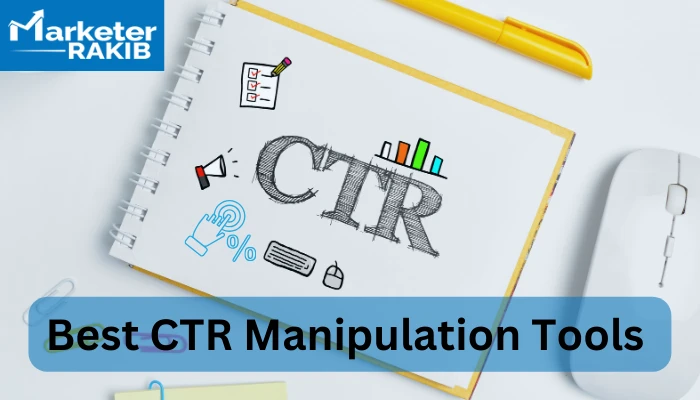Mastering CTR Manipulation: Tips for Increased Click-Through Effectiveness
Enhancing click-through rates (CTR) is a fundamental facet of electronic advertising and marketing methods, yet mastering the art of CTR adjustment requires a nuanced method. By concentrating on vital components such as meta descriptions, abundant bits, and A/B screening, marketers can considerably affect the performance of their projects. In a landscape where competition is strong and individual actions constantly evolving, remaining in advance demands a much deeper understanding of these strategies and a dedication to constant renovation. The world of CTR adjustment holds untapped potential for those willing to discover its intricacies and unlock its complete impact on digital success.

Comprehending CTR and Its Effect
Recognizing click-through rate (CTR) and its influence is crucial for any individual included in digital advertising. CTR is a key performance indication that measures the effectiveness of an online ad or content by determining the percent of individuals that clicked on a particular link out of the overall number of impressions it obtained. A high CTR indicates that the ad or material is resonating well with the audience, while a low CTR suggests the opposite.
CTR is important due to the fact that it straight affects the success of electronic advertising projects. A high CTR not only drives even more traffic to a web site however also boosts its online search engine ranking. Online search engine like Google take into consideration CTR as a strong signal of an advertisement's relevance and quality, which can bring about greater advertisement placements and lower expenses per click.
In addition, understanding CTR allows marketing professionals to optimize their campaigns by testing different ad elements, such as headlines, pictures, and calls-to-action, to boost efficiency. By assessing CTR data, online marketers can make informed decisions to enhance the performance of their digital marketing efforts.
Crafting Compelling Meta Descriptions
Crafting engaging meta descriptions plays a pivotal duty in driving individual engagement and click-through prices on search engine result web pages. Meta descriptions are the brief bits displayed below the web page title in search engine result, offering a succinct summary of the web page's content. To develop efficient meta descriptions, it is critical to keep them within the advised length of around 150-160 personalities to guarantee they are fully displayed on search engine results web pages.
When crafting meta descriptions, it is crucial to include targeted key phrases appropriate to the web content of the webpage. These keywords need to match the customer's search intent, raising the possibility of users clicking through to the website. Furthermore, integrating a call-to-action within the meta summary can motivate users to take the desired activity, whether it's clicking with to read a post, purchase, or enroll in a solution.

Leveraging Abundant Snippets and Schema Markup
To enhance the visibility and relevance of internet search engine results, site owners can leverage rich snippets and schema markup. Rich fragments are extra pieces of information displayed anchor in search results page that supply individuals with a sneak peek of the material on a webpage. By consisting of structured data in the kind of schema markup, website proprietors can help online search engine much better understand the context of their web content, bring about even more insightful and visually enticing search results page.
Carrying out schema markup enables search engines to present abundant bits that can consist of details like scores, testimonials, rates, and Check Out Your URL item schedule straight in the search results page. This added details can substantially boost the click-through rate by giving users with a far better understanding of what the webpage offers prior to they even visit it. Furthermore, abundant snippets can make search outcomes stand apart from competitors, drawing more attention and possibly leading to higher click-through prices.
Including rich snippets and schema markup right into a website's search engine optimization approach can enhance search engine result presence, increase customer involvement, and inevitably drive even more website traffic to the website. - GMB CTR Manipulation
A/B Testing Methods for Optimal CTR
Enhancing the click-through price (CTR) of a website is essential for maximizing its on the internet performance and achieving marketing objectives. A/B screening is a powerful technique that allows marketers to compare two variations of a web page or aspect to identify which one executes better in regards to CTR. By conducting A/B examinations, marketers can identify what resonates ideal with their target market and make data-driven choices to maximize their CTR.
When carrying out A/B testing for optimal CTR, it is vital to concentrate on one variable at once to accurately measure its influence. Aspects such as headlines, call-to-action switches, photos, or also color pattern can dramatically influence CTR. next By testing these components separately, marketing experts can determine what drives the many engagement from their target market.
Furthermore, it is critical to make sure that the example dimension for A/B tests is statistically substantial to draw dependable verdicts. On a regular basis keeping track of and assessing the results of A/B tests will certainly offer useful insights into customer behavior and choices, enabling constant optimization for boosted CTR performance.
Tracking and Assessing CTR Performance
Reliable surveillance and evaluation of click-through rate (CTR) performance are essential parts of any effective electronic advertising strategy (LinkDaddy CTR Manipulation). By closely keeping an eye on CTR information, online marketers can get beneficial understandings right into the performance of their projects, permitting informed decision-making and optimization efforts. On a regular basis tracking CTR metrics throughout various channels and campaigns offers a detailed sight of target market involvement and project efficiency
Assessing CTR efficiency entails assessing factors such as ad copy, visuals, targeting techniques, and landing page relevance to identify what resonates most with the target audience. By leveraging tools like Google Analytics, marketing experts can dive much deeper right into CTR patterns, segmenting information to comprehend performance variations across various demographics, tools, and areas.
Constant tracking and analysis enable marketers to recognize underperforming locations and carry out targeted enhancements to boost CTR (CTR Manipulation Press Release). Furthermore, contrasting CTR metrics versus market benchmarks can provide beneficial context and help set realistic efficiency goals. Overall, a data-driven strategy to surveillance and evaluating CTR performance is vital for enhancing digital advertising and marketing initiatives and achieving greater click-through effectiveness
Conclusion
To conclude, mastering CTR control requires a critical method that focuses on crafting engaging meta descriptions, leveraging abundant bits, executing A/B screening techniques, and consistently checking and evaluating CTR efficiency. By aligning with individual intent, including pertinent keyword phrases, and utilizing data-driven methods, businesses can raise their click-through efficiency and improve total campaign performance. It is necessary to continuously fine-tune and enhance strategies to stay affordable in the electronic landscape.